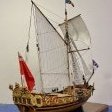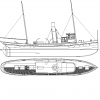-
Posts
3,084 -
Joined
-
Last visited
Reputation Activity
-
 Jaager got a reaction from Roger Pellett in Have a extra $100.00 to spend......
Jaager got a reaction from Roger Pellett in Have a extra $100.00 to spend......
In this situation, I would hold the money until I progressed in a build to a place where a specific tool is needed and then buy it. If you have a large budget - buying tools on spec, or collecting anything that could possibly be of use, is a no risk, no hardship behavior. If the expenditure has an effect, that is not a sustainable aspect.
-
 Jaager got a reaction from catopower in Have a extra $100.00 to spend......
Jaager got a reaction from catopower in Have a extra $100.00 to spend......
In this situation, I would hold the money until I progressed in a build to a place where a specific tool is needed and then buy it. If you have a large budget - buying tools on spec, or collecting anything that could possibly be of use, is a no risk, no hardship behavior. If the expenditure has an effect, that is not a sustainable aspect.
-
 Jaager got a reaction from druxey in Have a extra $100.00 to spend......
Jaager got a reaction from druxey in Have a extra $100.00 to spend......
In this situation, I would hold the money until I progressed in a build to a place where a specific tool is needed and then buy it. If you have a large budget - buying tools on spec, or collecting anything that could possibly be of use, is a no risk, no hardship behavior. If the expenditure has an effect, that is not a sustainable aspect.
-
 Jaager got a reaction from John Cheevers in Have a extra $100.00 to spend......
Jaager got a reaction from John Cheevers in Have a extra $100.00 to spend......
In this situation, I would hold the money until I progressed in a build to a place where a specific tool is needed and then buy it. If you have a large budget - buying tools on spec, or collecting anything that could possibly be of use, is a no risk, no hardship behavior. If the expenditure has an effect, that is not a sustainable aspect.
-
 Jaager got a reaction from allanyed in Have a extra $100.00 to spend......
Jaager got a reaction from allanyed in Have a extra $100.00 to spend......
In this situation, I would hold the money until I progressed in a build to a place where a specific tool is needed and then buy it. If you have a large budget - buying tools on spec, or collecting anything that could possibly be of use, is a no risk, no hardship behavior. If the expenditure has an effect, that is not a sustainable aspect.
-
 Jaager got a reaction from DarkAngel in How to best apply stains
Jaager got a reaction from DarkAngel in How to best apply stains
A stain is essentially a paint. If you apply it before glue assembly - there is a chance that the glue joint will fail because the stain will keep the glue from penetrating the wood. Give some thought to using an aqueous or alcohol based wood dye. It penetrates the wood instead of being a surface coat. If it is water based, you first wet the wood with water or water with some PVA glue mixed in. This will raise the grain - the wood is sanded when dry and then dyed. It will not need to be sanded again so no removal of dye. The wood will glue as well as it will in a raw state. A clear satin or matt finish applied after assembly. A dye will leave the wood looking as though it was the original wood - instead of the "muddy" effect of a stain.
-
 Jaager got a reaction from mtaylor in 'Cedar of Lebanon' wood, Cedrus libani
Jaager got a reaction from mtaylor in 'Cedar of Lebanon' wood, Cedrus libani
Will it scale well, or does it neon flash its presence?
Does it scale well?
If it has closed pores and an indistinct variation between Spring and Summer rings?
If to your eye, a cut and fine sanded surface would show well on a model, it would be a waste to hide it as a carved hull - if it is difficult to source. If if fails these tests, then carving a hull using it would work, if the Database is correct about its compatibility with wood glue. It is in the Lime, Spruce, Fir, White Pine, Aspen range of hardness. It should carve easily.
-
 Jaager got a reaction from bruce d in 'Cedar of Lebanon' wood, Cedrus libani
Jaager got a reaction from bruce d in 'Cedar of Lebanon' wood, Cedrus libani
Will it scale well, or does it neon flash its presence?
Does it scale well?
If it has closed pores and an indistinct variation between Spring and Summer rings?
If to your eye, a cut and fine sanded surface would show well on a model, it would be a waste to hide it as a carved hull - if it is difficult to source. If if fails these tests, then carving a hull using it would work, if the Database is correct about its compatibility with wood glue. It is in the Lime, Spruce, Fir, White Pine, Aspen range of hardness. It should carve easily.
-
 Jaager got a reaction from DaveBaxt in Stairs on the hull planking and on the wale
Jaager got a reaction from DaveBaxt in Stairs on the hull planking and on the wale
The last picture = is likely a first rate or ship expected to be a flagship. The change is at an entry "door". Only the "plebs" would be using the steps above the door. There is even a wider step at the level of the upper gun deck for those who use the gun port at that level instead of climbing to the rail.
The steps for the fat old men (flag oficiers) are wider and more uniform.
-
 Jaager got a reaction from mtaylor in Stairs on the hull planking and on the wale
Jaager got a reaction from mtaylor in Stairs on the hull planking and on the wale
The last picture = is likely a first rate or ship expected to be a flagship. The change is at an entry "door". Only the "plebs" would be using the steps above the door. There is even a wider step at the level of the upper gun deck for those who use the gun port at that level instead of climbing to the rail.
The steps for the fat old men (flag oficiers) are wider and more uniform.
-
 Jaager got a reaction from DaveBaxt in Stairs on the hull planking and on the wale
Jaager got a reaction from DaveBaxt in Stairs on the hull planking and on the wale
Building codes specify stairs have specific height and depth ratios - I think our brains quickly adapt to and expect a rhythm when climbing a manufactured apparatus. The "bulge" at a wale would be easier to adapt to than a difference in step depth or distance between steps. Since most vessels had significant tumble home, the body contact with the higher steps would signal where a foot should go.
-
 Jaager got a reaction from Ferit in Stairs on the hull planking and on the wale
Jaager got a reaction from Ferit in Stairs on the hull planking and on the wale
Building codes specify stairs have specific height and depth ratios - I think our brains quickly adapt to and expect a rhythm when climbing a manufactured apparatus. The "bulge" at a wale would be easier to adapt to than a difference in step depth or distance between steps. Since most vessels had significant tumble home, the body contact with the higher steps would signal where a foot should go.
-
 Jaager got a reaction from Canute in Mini (micro) drill bits in bulk, not sets.
Jaager got a reaction from Canute in Mini (micro) drill bits in bulk, not sets.
Amazon sells as an example
yros 45-21270 High Speed Steel Wire Gauge Drill Bit No.70 #12
full range of wire gauge - not seeing metric
-
 Jaager got a reaction from mtaylor in Mini (micro) drill bits in bulk, not sets.
Jaager got a reaction from mtaylor in Mini (micro) drill bits in bulk, not sets.
Amazon sells as an example
yros 45-21270 High Speed Steel Wire Gauge Drill Bit No.70 #12
full range of wire gauge - not seeing metric
-
 Jaager got a reaction from Canute in adapt this idea for a small spray both?
Jaager got a reaction from Canute in adapt this idea for a small spray both?
Wearing a tie anywhere close to a lathe- really insane.
-
 Jaager got a reaction from thibaultron in Mini Power Drill
Jaager got a reaction from thibaultron in Mini Power Drill
MPJA sells a power supply for $17 3-12 volt selection range. Allows for a range of RPM.
-
 Jaager got a reaction from Canute in Sealing hull before I paint it with an acrylic paint
Jaager got a reaction from Canute in Sealing hull before I paint it with an acrylic paint
Use of a primer with paint probably comes from full size practice. The first coat soaks in, uses a lot of paint, and leaves an incomplete surface. A primer came have a budget level cost and finish paint can be expensive. For large surfaces and a lot of paint, it saves money by using a primer.
If you have a surplus of finish color, a separate primer has no savings advantage, so using the finish as primer will work.
If the surface has a mold invasion, or it is a wood species with sap or rosin, a proper sealing primer is usually wise, it keeps the mold or sap from migrating to the surface over time.
I wonder if the advise to use poly as a primer came from a source who thought a way was found to show up the traditional suggestions made by professionals in wood finishing. Polyurethane is a synthetic plastic, if you are not a moldy fig about using "modern" materials on a model, it seems to have been shown to have stability over time.
-
 Jaager got a reaction from Canute in Sealing hull before I paint it with an acrylic paint
Jaager got a reaction from Canute in Sealing hull before I paint it with an acrylic paint
A long time traditional first coat is shellac. It is pretty much compatible with everything. It is cut 1:1 with alcohol for the first coat.
As a final finish, it must be kept from water, Water turns it white.
Many sand and sealer formulations are designed to be a primary base for open pore wood species - such as Oak, Willow, Ash, Walnut. It fills the pores and has a smooth surface for a final clear finish product. These are generally thick and leave a layer that is out of scale on a model. I prefer to avoid using wood species that have open pores - unless it is not visible.
0000 steel wool between coats, leaves "tooth" for the next coat to bind with. Just vacuum and tack rag to remove any steel fibers. They will rust and stain.
-
 Jaager got a reaction from mtaylor in Plans for Hermaphrodite Brig
Jaager got a reaction from mtaylor in Plans for Hermaphrodite Brig
The plans in HIC books are for sale from The Smithsonian.
For the Antebellum USN many/most of the vessels designed as schooners or brigantines were rigged as brigs.
The rig was a bit fluid. It appears to me that you could pick most any brig, brigantine, or 2 masted schooner hull plan and mast and rig it as a hermaphrodite brig. It would be helpful to give your model a fictional name, to avoid integrity problems.
-
 Jaager got a reaction from thibaultron in How to Print PDF Files to Scale
Jaager got a reaction from thibaultron in How to Print PDF Files to Scale
Painter and Paint Shop Pro will both import PDF images. For free I would put money on GIMP doing it.
-
 Jaager got a reaction from GrandpaPhil in Plans for Hermaphrodite Brig
Jaager got a reaction from GrandpaPhil in Plans for Hermaphrodite Brig
The plans in HIC books are for sale from The Smithsonian.
For the Antebellum USN many/most of the vessels designed as schooners or brigantines were rigged as brigs.
The rig was a bit fluid. It appears to me that you could pick most any brig, brigantine, or 2 masted schooner hull plan and mast and rig it as a hermaphrodite brig. It would be helpful to give your model a fictional name, to avoid integrity problems.
-
 Jaager got a reaction from Griphos in Sealing hull before I paint it with an acrylic paint
Jaager got a reaction from Griphos in Sealing hull before I paint it with an acrylic paint
Use of a primer with paint probably comes from full size practice. The first coat soaks in, uses a lot of paint, and leaves an incomplete surface. A primer came have a budget level cost and finish paint can be expensive. For large surfaces and a lot of paint, it saves money by using a primer.
If you have a surplus of finish color, a separate primer has no savings advantage, so using the finish as primer will work.
If the surface has a mold invasion, or it is a wood species with sap or rosin, a proper sealing primer is usually wise, it keeps the mold or sap from migrating to the surface over time.
I wonder if the advise to use poly as a primer came from a source who thought a way was found to show up the traditional suggestions made by professionals in wood finishing. Polyurethane is a synthetic plastic, if you are not a moldy fig about using "modern" materials on a model, it seems to have been shown to have stability over time.
-
 Jaager got a reaction from thibaultron in How to Print PDF Files to Scale
Jaager got a reaction from thibaultron in How to Print PDF Files to Scale
One way - use a draw/photo program that can open PDF files. A file with a legend printed on your home printer. Match the legend to a 1;48 architects ruler and adjust the scale of the file until the % adjustment needed to match is obtained.
Except for a few components, a 8.5 x 14 sheet should reproduce most any part.
I did the Body and needed to scale it up by 105% to match the 33'7" breadth.
The profile 103% Horizontal and 104.8% Vertical to get the station intervals and heights to spec.
-
 Jaager got a reaction from mtaylor in How to Print PDF Files to Scale
Jaager got a reaction from mtaylor in How to Print PDF Files to Scale
One way - use a draw/photo program that can open PDF files. A file with a legend printed on your home printer. Match the legend to a 1;48 architects ruler and adjust the scale of the file until the % adjustment needed to match is obtained.
Except for a few components, a 8.5 x 14 sheet should reproduce most any part.
I did the Body and needed to scale it up by 105% to match the 33'7" breadth.
The profile 103% Horizontal and 104.8% Vertical to get the station intervals and heights to spec.
-
 Jaager got a reaction from mtaylor in Sealing hull before I paint it with an acrylic paint
Jaager got a reaction from mtaylor in Sealing hull before I paint it with an acrylic paint
Use of a primer with paint probably comes from full size practice. The first coat soaks in, uses a lot of paint, and leaves an incomplete surface. A primer came have a budget level cost and finish paint can be expensive. For large surfaces and a lot of paint, it saves money by using a primer.
If you have a surplus of finish color, a separate primer has no savings advantage, so using the finish as primer will work.
If the surface has a mold invasion, or it is a wood species with sap or rosin, a proper sealing primer is usually wise, it keeps the mold or sap from migrating to the surface over time.
I wonder if the advise to use poly as a primer came from a source who thought a way was found to show up the traditional suggestions made by professionals in wood finishing. Polyurethane is a synthetic plastic, if you are not a moldy fig about using "modern" materials on a model, it seems to have been shown to have stability over time.













